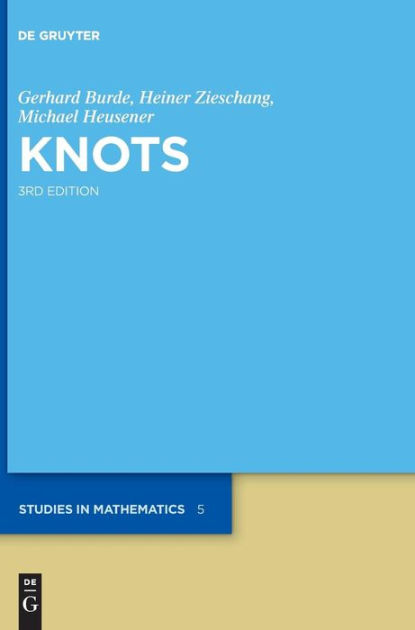Copies of the classnotes are on the internet in PDF format as given below. The "Proofs of Theorems" files were prepared in Beamer. The "Printout of Proofs" are printable PDF files of the Beamer slides without the pauses. These notes and supplements have not been classroom tested (and so may have some typographical errors).
ETSU does not have a formal graduate class on knot theory.
I have Introduction to Knot Theory notes based on Charles Livingston's Knot Theory, The Carus Mathematical Monographs, Volume 24 (MAA, 1993).
Chapter 1. Knots and Isotopies.
- Section 1.A. Knots.
- Section 1.B. Equivalence of Knots.
- Section 1.C. Knot Projections.
- Section 1.D. Global Geometric Properties.
- Section 1.E. History and Sources.
- Section 1.F. Exercises.
- Study Guide 1.
Chapter 2. Geometric Concepts.
- Section 2.A. Geometric Properties of Projections.
- Section 2.B. Seifert Surfaces and Genus.
- Section 2.C. Companion Knots and Product Knots.
- Section 2.D. Braids, Bridges, Plats.
- Section 2.E. Slice Knots and Algebraic Knots.
- Section 2.F. History and Sources.
- Section 2.G. Exercises.
- Study Guide 2.
Chapter 3. Knot Groups.
- Section 3.A. Homology.
- Section 3.B. Wirtinger Presentation.
- Section 3.C. Peripheral System.
- Section 3.D. Knots on Handlebodies.
- Section 3.E. Torus Knots.
- Section 3.F. Asphericity of the Knot Complement.
- Section 3.G. History and Sources.
- Section 3.H. Exercises.
- Study Guide 3.
Chapter 4. Commutator Subgroup of a Knot Group.
- Section 4.A. Construction of Cyclic Coverings.
- Section 4.B. Structure of the Commutator Subgroup.
- Section 4.C. A Lemma of Brown and Crowell.
- Section 4.D. Examples and Applications.
- Section 4.E. Commutator Subgroups of Satellites.
- Section 4.F. History and Sources.
- Section 4.G. Exercises.
- Study Guide 4.
Chapter 5. Fibred Knots.
- Section 5.A. Fibration Theorem.
- Section 5.B. Fibred Knots.
- Section 5.C. Applications and Examples.
- Section 5.D. History and Sources.
- Section 5.E. Exercises.
- Study Guide 5.
Chapter 6. Characterization of Torus Knots.
- Section 6.A. Results and Sources.
- Section 6.B. Proof of the Main Theorem.
- Section 6.C. Remarks on the Proofs.
- Section 6.D. History and Sources.
- Section 6.E. Exercises.
- Study Guide 6.
Chapter 7. Torus Knots.
- Section 7.A. Composition of Knots.
- Section 7.B. Uniqueness of the Decomposition into Prime Knots: Proof.
- Section 7.C. Fibred Knots and Decompositions.
- Section 7.D. History and Sources.
- Section 7.E. Exercises.
- Study Guide 7.
Chapter 8. Cyclic Coverings and Alexander Invariants.
- Section 8.A. The Alexander Module.
- Section 8.B. Infinite Cyclic Coverings and Alexander Modules.
- Section 8.C. Homological Properties of C∞.
- Section 8.D. Alexander Polynomials.
- Section 8.E. Finite Cyclic Coverings.
- Section 8.F. History and Sources.
- Section 8.G. Exercises.
- Study Guide 8.
Chapter 9. Free Differential Calculus and Alexander Matrices.
- Section 9.A. Regular Coverings and Homotopy Chains.
- Section 9.B. Fox Differential Calculus.
- Section 9.C. Calculation of Alexander Polynomials.
- Section 9.D. Alexamnder Polynomials of Links.
- Section 8.E. Finite Cyclic Coverings Again.
- Section 8.F. History and Sources.
- Section 8.G. Exercises.
- Study Guide 9.
Chapter 10. Braids.
- Section 10.A. The Classification of Braids.
- Section 10.B. Normal Formand Group Structure.
- Section 10.C. Configuration Spaces and Braid Groups.
- Section 10.D. Braids and Links.
- Section 10.E. History and Sources.
- Section 10.F. Exercises.
- Study Guide 10.
Chapter 11. Manifolds as Branched Coverings.
- Section 11.A. The Jones Polynomial.
- Section 11.B. The Basic Characteristics of the Jones Polynomial.
- Section 11.C. History and Sources.
- Section 11.D. Exercises.
- Study Guide 11.
Chapter 12. Montesinos Links.
- Section 12.A. Schubert's Normal Form of Knots and Links with Two Bridges.
- Section 12.B. Viergeflechte (4-Plats).
- Section 12.C. Alexander Polynomial and Genus of a Knot with Two Bridges.
- Section 12.D. Classification of Montesinos Links.
- Section 12.E. Symmetries of Montesinos Links.
- Section 12.F. History and Sources.
- Section 12.G. Exercises.
- Study Guide 12.
Chapter 13. Quadratic Forms of a Knot.
- Section 13.A. The Quadratic Form of a Knot.
- Section 13.B. Computation of the Quadratic Form of a Knot.
- Section 13.C. Alternating Knots and Links.
- Section 13.D. Comparison of Different Concepts and Examples.
- Section 13.E. History and Sources.
- Section 13.F. Exercises.
- Study Guide 13.
Chapter 14. Representations of Knot Groups.
- Section 14.A. Metabelian Representations.
- Section 14.B. Homomorphisms of 𝔊 into the Group of Motions of the Euclidean Plane.
- Section 14.C. Linkage in Coverings.
- Section 14.D. Periodic Knots.
- Section 14.E. History and Sources.
- Section 14.F. Exercises.
- Study Guide 14.
Chapter 15. Knots, Knot Manifolds, and Knot Groups.
- Section 15.A. Examples.
- Section 15.B. Property P for Special Knots.
- Section 15.C. Prime Knots and their Manifolds and Groups.
- Section 15.D. Groups of Product Knots.
- Section 15.E. History and Sources.
- Section 15.F. Exercises.
- Study Guide 15.
Chapter 16. The 2-variable skein polynomial.
- Section 16.A. Construction of a trace function on a Hecke algebra.
- Section 16.B. The HOMFLY polynomial.
- Section 16.C. History and Sources.
- Section 16.D. Exercises.
- Study Guide 16.
Appendix.
- Appendix A. Algebraic Theorems.
- Appendix B. Theorems of 3-dimentional Topology.
- Appendix C. Tables.
- Appendix D. Knot projections 01-949.
Return to
Bob Gardner's home page

